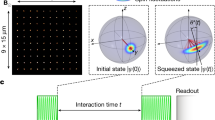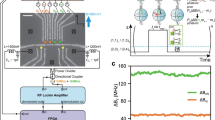Abstract
Controlling the quantum entanglement between parts of a many-body system is key to unlocking the power of quantum technologies such as quantum computation, high-precision sensing, and the simulation of many-body physics. The spin degrees of freedom of ultracold neutral atoms in their ground electronic state provide a natural platform for such applications thanks to their long coherence times and the ability to control them with magneto-optical fields. However, the creation of strong coherent coupling between spins has been challenging. Here we demonstrate a strong and tunable Rydberg-dressed interaction between spins of individually trapped caesium atoms with energy shifts of order 1 MHz in units of Planck’s constant. This interaction leads to a ground-state spin-flip blockade, whereby simultaneous hyperfine spin flips of two atoms are inhibited owing to their mutual interaction. We employ this spin-flip blockade to rapidly produce single-step Bell-state entanglement between two atoms with a fidelity ≥81(2)%.
This is a preview of subscription content, access via your institution
Access options
Subscribe to this journal
Receive 12 print issues and online access
$209.00 per year
only $17.42 per issue
Buy this article
- Purchase on Springer Link
- Instant access to full article PDF
Prices may be subject to local taxes which are calculated during checkout




Similar content being viewed by others
References
Awschalom, D. D., Bassett, L. C., Dzurak, A. S., Hu, E. L. & Petta, J. R. Quantum spintronics: Engineering and manipulating atom-like spins in semiconductors. Science 339, 1174–1179 (2013).
Devoret, M. H. & Schoelkopf, R. J. Superconducting circuits for quantum information: An outlook. Science 339, 1169–1174 (2013).
Barends, R. et al. Superconducting quantum circuits at the surface code threshold for fault tolerance. Nature 508, 500–503 (2014).
O’Brien, J. L., Furusawa, A. & Vuckovic, J. Photonic quantum technologies. Nature Photon. 3, 687–695 (2009).
Brown, K. et al. Single-qubit-gate error below 10−4 in a trapped ion. Phys. Rev. A 84, 030303 (2011).
Monroe, C. & Kim, J. Scaling the ion trap quantum processor. Science 339, 1164–1169 (2013).
Nigg, D. et al. Quantum computations on a topologically encoded qubit. Science 345, 302–305 (2014).
Nelson, K. D., Li, X. & Weiss, D. S. Imaging single atoms in a three-dimensional array. Nature Phys. 3, 556–560 (2007).
Zhang, X., Isenhower, L., Gill, A., Walker, T. & Saffman, M. Deterministic entanglement of two neutral atoms via Rydberg blockade. Phys. Rev. A 82, 030306 (2010).
Wilk, T. et al. Entanglement of two individual neutral atoms using Rydberg blockade. Phys. Rev. Lett. 104, 010502 (2010).
Appel, J. et al. Mesoscopic atomic entanglement for precision measurements beyond the standard quantum limit. Proc. Natl Acad. Sci. USA 106, 10960–10965 (2009).
Bloom, B. J. et al. An optical lattice clock with accuracy and stability at the 10–18 level. Nature 506, 71–75 (2014).
Gil, L. I. R., Mukherjee, R., Bridge, E. M., Jones, M. P. A. & Pohl, T. Spin squeezing in a Rydberg lattice clock. Phys. Rev. Lett. 112, 103601 (2014).
Dickerson, S. M., Hogan, J. M., Sugarbaker, A., Johnson, D. M. S. & Kasevich, M. A. Multiaxis inertial sensing with long-time point source atom interferometry. Phys. Rev. Lett. 111, 083001 (2013).
Parazzoli, L. P., Hankin, A. M. & Biederman, G. W. Observation of free-space single-atom matterwave interference. Phys. Rev. Lett. 109, 230401 (2012).
Steffen, A. et al. Digital atom interferometer with single particle control on a discretized space-time geometry. Proc. Natl Acad. Sci. USA 109, 9770–9774 (2012).
Bloch, I., Dalibard, J. & Nascimbene, S. Quantum simulations with ultracold quantum gases. Nature Phys. 8, 267–276 (2012).
Glaetzle, A. W. et al. Designing frustrated quantum magnets with laser-dressed Rydberg atoms. Phys. Rev. Lett. 114, 173002 (2015).
Brennen, G. K., Caves, C. M., Jessen, P. S. & Deutsch, I. H. Quantum logic gates in optical lattices. Phys. Rev. Lett. 82, 1060–1063 (1999).
Jaksch, D., Briegel, H.-J., Cirac, J., Gardiner, C. & Zoller, P. Entanglement of atoms via cold controlled collisions. Phys. Rev. Lett. 82, 1975–1978 (1999).
Jaksch, D. et al. Fast quantum gates for neutral atoms. Phys. Rev. Lett. 85, 2208–2211 (2000).
Lukin, M. et al. Dipole blockade and quantum information processing in mesoscopic atomic ensembles. Phys. Rev. Lett. 87, 037901 (2001).
Hankin, A. M. et al. Two-atom Rydberg blockade using direct 6s to np excitation. Phys. Rev. A 89, 033416 (2014).
Isenhower, L. et al. Demonstration of a neutral atom controlled-not quantum gate. Phys. Rev. Lett. 104, 010503 (2010).
Bouchoule, I. & Mølmer, K. Spin squeezing of atoms by the dipole interaction in virtually excited Rydberg states. Phys. Rev. A 65, 041803 (2002).
Johnson, J. & Rolston, S. Interactions between Rydberg-dressed atoms. Phys. Rev. A 82, 033412 (2010).
Balewski, J. B. et al. Rydberg dressing: Understanding of collective many-body effects and implications for experiments. New J. Phys. 16, 063012 (2014).
Pupillo, G., Micheli, A., Boninsegni, M., Lesanovsky, I. & Zoller, P. Strongly correlated gases of Rydberg-dressed atoms: Quantum and classical dynamics. Phys. Rev. Lett. 104, 223002 (2010).
Yan, S., Huse, D. A. & White, S. R. Spin-liquid ground state of the s = 1/2 kagome Heisenberg antiferromagnet. Science 332, 1173–1176 (2011).
Keating, T. et al. Adiabatic quantum computation with Rydberg-dressed atoms. Phys. Rev. A 87, 052314 (2013).
Keating, T. et al. Robust quantum logic in neutral atoms via adiabatic Rydberg dressing. Phys. Rev. A 91, 012337 (2015).
Schwettmann, A., Crawford, J., Overstreet, K. & Shaffer, J. Cold cs Rydberg-gas interactions. Phys. Rev. A 74, 020701 (2006).
Bollinger, J., Itano, W., Wineland, D. & Heinzen, D. Optimal frequency measurements with maximally correlated states. Phys. Rev. A 54, R4649–R4652 (1996).
Sackett, C. A. et al. Experimental entanglement of four particles. Nature 404, 256–259 (2000).
Acknowledgements
We would like to thank L. P. Parazzoli and C. W. Chou for their early work on the experimental system. We also thank J. Lee for comments on the manuscript. This work was supported by the Laboratory Directed Research and Development programme at Sandia National Laboratories and through the National Science Foundation’s Center for Quantum Information and Control NSF-1212445.
Author information
Authors and Affiliations
Contributions
Experimental work by Y.-Y.J., A.M.H. and G.W.B. Numerical modelling by Y.-Y.J. Theoretical work by I.H.D. and T.K.
Corresponding author
Ethics declarations
Competing interests
The authors declare no competing financial interests.
Supplementary information
Supplementary information
Supplementary information (PDF 372 kb)
Rights and permissions
About this article
Cite this article
Jau, YY., Hankin, A., Keating, T. et al. Entangling atomic spins with a Rydberg-dressed spin-flip blockade. Nature Phys 12, 71–74 (2016). https://doi.org/10.1038/nphys3487
Received:
Accepted:
Published:
Issue Date:
DOI: https://doi.org/10.1038/nphys3487
This article is cited by
-
Fast nuclear-spin gates and electrons-nuclei entanglement of neutral atoms in weak magnetic fields
Frontiers of Physics (2024)
-
A subwavelength atomic array switched by a single Rydberg atom
Nature Physics (2023)
-
Floquet-tailored Rydberg interactions
Nature Communications (2023)
-
Realizing spin squeezing with Rydberg interactions in an optical clock
Nature (2023)
-
Quantum computing with Rydberg atom graphs
Journal of the Korean Physical Society (2023)



